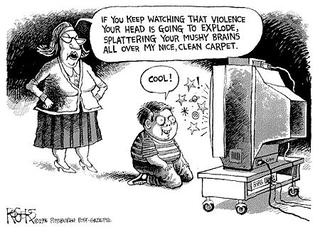By DONNA GORDON BLANKINSHIP
The Associated Press
SEATTLE — Teaching parents to switch channels from violent shows to educational TV can improve preschoolers’ behavior, even without getting them to watch less, a new study found.
The results were modest and faded over time but may hold promise for finding ways to help young children avoid aggressive, violent behavior, the study authors and other doctors said.
“It’s not just about turning off the television. It’s about changing the channel. What children watch is as important as how much they watch,” said lead author Dr. Dimitri Christakis, a University of Washington researcher and a pediatrician at Seattle Children’s.
The research was published online Monday by the journal Pediatrics.
The study involved 565 Seattle parents, who periodically filled out TV-watching diaries and questionnaires measuring their child’s behavior.
Half were coached for six months on getting their 3- to 5-year-old kids to watch shows like “Sesame Street” and “Dora the Explorer” rather than more violent programs like “Power Rangers.”
The results were compared with kids whose parents got advice on healthful eating instead.
At six months, children in both groups showed improved behavior, but there was a little bit more improvement in the group that was coached on their TV watching.
By one year, there was no meaningful difference between the two groups overall. Low-income boys appeared to get the most short-term benefit.
“That’s important because they are at the greatest risk, both for being perpetrators of aggression in real life, but also being victims of aggression,” Christakis said.
The study has flaws. The parents weren’t told the purpose, but the authors concede they probably figured it out and that might have affected the results.
Before the study, the children averaged about 1½ hours of TV, video and computer game watching a day, with violent content making up about a quarter of that time.
By the end of the study, that increased by up to 10 minutes. Those in the TV coaching group increased their time with positive shows; the healthful-eating group watched more violent TV.
Nancy Jensen, who took part with her now 6-year-old daughter, said the study was a wake-up call.
“I didn’t realize how much Elizabeth was watching and how much she was watching on her own,” she said.
Jensen said her daughter’s behavior improved after making changes, and she continues to control what Elizabeth and her 2-year-old brother, Joe, watch.
She also decided to replace most of Elizabeth’s TV time with games, art and outdoor fun.
During a recent visit to their Seattle home, the children seemed more interested in playing with blocks and running around outside than watching TV.
Another researcher who was not involved in this study but also focuses his work on kids and television commended Christakis.
“I think it’s fabulous that people are looking on the positive side. Because no one’s going to stop watching TV, we have to have viable alternatives for kids,” said Dr. Michael Rich, director of the Center on Media and Child Health at Children’s Hospital Boston.

